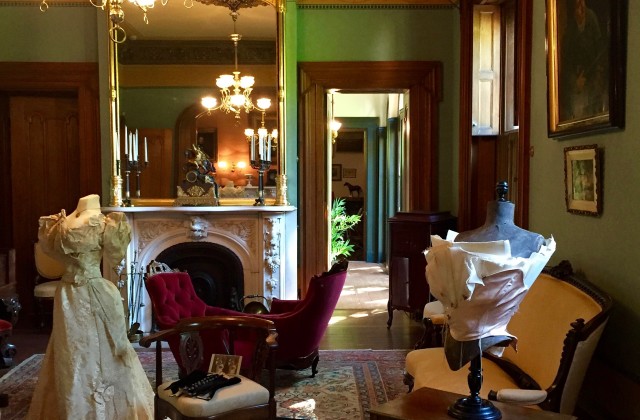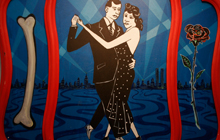The Loves of Aaron Burr: Portraits in Corsetry and Binding by Camilla Huey
Introduction to Camilla Huey’s The Loves of Aaron Burr: Portraits in Corsetry and Binding.
May – September, 2013. The Morris-Jumel Mansion, New York City.
May – July, 2016. The Henry Clay House, Lexington, Kentucky.
By Kurt Thometz
“You have heard me speak of a Miss Wollstonecraft, who has written something on the French Revolution; she has also written a book entitled The Vindication of the Rights of Women. I had heard it spoken of with a coldness little calculated to excite attention; but as I read with avidity and prepossession every thing written by a lady, I made hast to procure it, and spent the last night, almost the whole of it, in reading it. Be assured that your sex has in her an able advocate. It is, in my opinion, a work of genius. She has successfully adopted the style of Rousseau’s Emilius; and her comment on that work especially what relates to female education, contains more good sense than all the other criticisms upon him which I have seen put together. I promise myself much pleasure in reading it to you. Is it owing to ignorance or prejudice that I have not yet met a single person who had discovered or would allow the merit of this work?” Aaron Burr to his wife, Theodosia Prevost Burr, February 16, 1793.
Burr, the bête noire of the Founding Fathers, was a virile young Revolutionary War hero who’d have been American aristocracy if he hadn’t stood with the opposition. His wife was a widow of a British Officer with children, ten years Burr’s senior, that he married for love, honored and respected her intellectual acumen and principled manner:
“It was a knowledge of your mind which first inspired me with a respect for that of your sex, and with some regret, I confess, that the ideas which you have often heard me express in favor of female intellectual powers are founded on what I have imagined, more than what I have seen, except in you.” AB to Theodosia Prevost Burr, Feb. 14, 1794.
As a couple, Burr and his wife were radical revolutionaries practicing a doctrine few preached. The children of Calvinist theologians shaken by the Second Great Awakening, Theodosia and Aaron are found where Reformation Protestantism was being transformed by the Enlightenment’s liberal humanism into Romanticism. America, at the time, exemplified Romantic ideals: “With liberty and justice for all.”
The Burrs asserted that the road to Heaven was open to all alike. As disciples of both Mary Wollstonecraft and Thomas Paine, they were in the front lines of the Common Weal’s inclusive cause. They were among the country’s first abolitionists and considered the first feminists in America. As such they lived their beliefs by raising their daughter, “to convince the world [of] that [which] neither sex appear to believe – that women have souls.”
Whether owing to ignorance or prejudice, very few agreed with them. Despite Abigail Adam’s admonition to “Remember the ladies,” the American Revolution did little for women. The persons and property of women and their children were the property of men. If they were a cut above slavery it was with grudging consent. When they were not loved they could not buy their way out of marriage. Women and blacks have souls? They were property.
In Jefferson’s republic nearly all white men were created equal. Beyond his vested interests Jefferson didn’t venture. For the Federalist Alexander Hamilton white men and some black men with money were equal. Not women. Hamilton is complicated, labored and compromised. But in Burr’s unappreciated democracy Jefferson’s stated autonomies included all men and women in a common cause. It was as simple as it was elegant.
What democracies and republics share in common are the rights of the people as opposed to those of the sovereign. A democracy differs from a republic in being based on the best interest of the Common Weal, the average man – not the privileged. Common Sense, Tom Paine called it. Burr, the Romantic among the anti-colonialist Revolutionaries, seems to have grasped the principle of universal equivalence at the heart of democracy as an act of style. In that style, the goal of equal opportunity as civil rights, that eluded so many of the founders, is the golden mean a democracy attains.
Most of this country’s founders never intended it to be a democracy. Most presumed a republic wherein “businessmen could conduct business freely.” That would fairly characterize Hamilton’s rather exclusive economic policies, with their preference for privilege. The boom of industrial capitalism in post-revolutionary America brought about a bust in living standards for the great majority: women, blacks, and everyone other to Jefferson’s chosen few vulnerable to the inequitable equation.
Burr preferred a more inclusive democracy. If Burr was contrary to the oligarchy of money, it could hardly be attributed to a lack of entrepreneurial ambition. Neither was he pious in his beliefs. Like everyone, he is as much an opportunist as an idealist, a pragmatic if not a very successful capitalist. He had this in common with so many of the Founding Fathers, who were prone to marrying well and living well off their wives’ estate.
The pursuit of happiness isn’t entirely material. It can be both spiritual and animal. If Burr was successful with the ladies, it was for being a gentleman amongst the lot of misogynists and womanizers. And his reward was to be mentored by and to mentor the extraordinary women represented in this exhibition: as family, friends and mistresses. Burr loved each in their way. No rogue, no lascivious libertine, as Burr has been misrepresented, would have had the love and respect he enjoyed from all save perhaps the last of his women, Madame Jumel, the artist’s inspiration and Burr’s last match. She’s the exception. There’s always one.
*
“Aaron Burr was more than doubly unhappy in his fates. He lived too long – into the querulous years of senility. He made mistakes. He killed in a duel Alexander Hamilton, a man destined to be the idol of that huge section of the nation enamored of wealth, the founder of the party of Webster, Lincoln, McKinley and Coolidge. The code of honor among gentlemen at the time did not forbid dueling, but Burr shot the wrong man. Had he laid low Tom Paine, many a page of history that now condemns him would glow with praise. Burr’s second great error was to be outwitted by one of the most astute politicians and influential leaders in American history, Thomas Jefferson. Thus Burr was condemned by both powerful political parties. As Senator Beveridge once remarked to the present writer, republics will forgive men for mistakes, but parties, never.”
Charles A. Beard, The Aaron Burr Conspiracy and A New Light on Aaron Burr.
Walter Flavius McCaleb. NY: Wilson-Erickson, 1936.
Jefferson’s conspiracy against Burr culminates with slavery intact, women in their place and business conducted freely. Hamilton’s game had played out, Burr is compelled to put him out of his misery. The historian Roger G. Kennedy makes the argument that in Jefferson’s conspiracy for slavery’s destiny to manifest, Hamilton’s suicide by duel eliminates one abolitionist and exiles the other. In this Hamilton advanced Jefferson’s Imperialist cause.
Still, Burr’s democracy stood in Jefferson’s way. There’s nothing theoretical about the conspiracy to tarnish Burr’s reputation. Less Jefferson than his acolytes went straight for the libido. Burr’s chosen biographer, the executor of his estate, a supposed friend, furthers the damage to the man, compounded by his daughter Theodosia’s being lost at sea with a lifetime’s correspondence and his two volume manuscript of his eye witness account of the American Revolution. Matthew L. Davis’s burning of Burr’s letters to the women in his life, purporting them obscene, could be said to advance the same cause Isabel Burton accomplished in burning her feminist husband Richard’s letters.
From even this cruel editing we can still divine a man who loved women. By what has survived we can read of his relationships with several of the most liberated American women of the revolutionary and antebellum eras. Certainly, his relationship with his wife and daughter, the Theodosia, are exemplary – particularly regards the daughter’s education.
Some of these women’s stories have been as pushed aside and as vilified as Burr’s but here we have their stories told in their own words. The notorious fourteen-year old British spy, highlife author Margaret Moncrieffe, who credits Burr with her rebellion against “the barbarous customs of society.” Leonora Sansay, who writes one of the twelve first hand accounts we have of the Haitian Revolution as letters addressed to her confidante, Burr. His protégé, Jane McManus Cazneau, the pioneering journalist who coins the term ‘Manifest Destiny,’ who at fifty years Burr’s junior is none the less named as correspondent in the Burr v. Jumel Divorce and suffers unduly from the false accusation.
Madame Jumel is the character that Gore Vidal begins his rehabilitation of Burr with a cameo of the venial widow and bride, Madame Eliza Jumel. Her much celebrated beauty fading at fifty-nine, she is the richest, arguably the most liberated, woman in America just lately acquitted of the murder of her first husband. Her second husband, Burr, is still living down his own bad rap as Hamilton’s “assassin,” is seventy-eight, penniless and her legal counsel.
As for Eliza herself, had Defoe wholly set Moll Flanders in the New World it might have been titled Eliza Jumel. For that matter, she bears a striking resemblance to Defoe’s other grand horizontal, Roxana. Less competent hands have embraced the fictional biographical history Jumel inspired; a slattern to riches story involving several Founding Fathers with a good deal of bodice ripping, as often exposing truths deemed “dirty laundry.”
In Harlem Heights’ gossip Jumel seems less a creation of Mary Wollstonecraft than of Mary Shelley. As slandered as Burr, hers is a case of the facts not adding up to the truth. With so many of the court histories of our democracy fixing their attention on the sunny freedoms of a darkening legacy, these stories may not be as pretty but they are never the less truths. And truth, in all its complexity, is beautiful.
Kurt Thometz
May 2016

 Jumel Terrace B&B
Jumel Terrace B&B Life Turns Man Up & Down
Life Turns Man Up & Down The Private Library
The Private Library